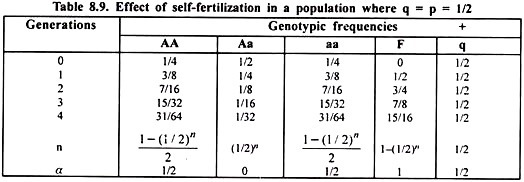ADVERTISEMENTS:
After reading this article we will learn about the consequences and co-efficient of inbreeding.
The mating of individuals more closely related than individuals mating at random is known as inbreeding. The most intense form of inbreeding is selfing.
Consequences of Inbreeding:
(i) Reduction in genetic variance within a small population
ADVERTISEMENTS:
(ii) General decrease in over-all heterozygosity
(iii) Differentiation of a population into homozygous subgroups
(iv) Increase in homozygosity
The genetic effect of self-fertilization in a population with p = q = 1/2 is given in Table 8.9.
Inbreeding Coefficient (F):
The degree of inbreeding in a population is usually measured by Wright’s inbreeding coefficient, F which is defined as:
(i) F expresses the amount of heterozygosity that has been lost.
For example, in Table 8.8, the proportion of heterozygous individuals in the initial population is 1/2. It is 1/16 in the 3rd generation.
Hence, reduction in heterozygosity is:
1/2 – 1/16 = 7/16 and if
1/2x = 7/16
X = 7 x 2/16 x 1 = 7/8 = F
(ii) F is defined as the probability that the 2 allelic genes in an individual (or 2 gametes that gave rise to the individual) are identical by descent, i.e. both have descended from the same gene in some common ancestor. For example,
The chance that father receives A, gene is 1/2 and further, the chance that it will be passed on to the son is again 1/2. Thus, the probability that the son will get A1 from grandfather by way of his father is 1/2 x 1/2 = 1/4. Similarly, the probability that the son will receive A1 from grandfather via mother is also 1/2 x 1/2 — 1/4. Thus, the chance that the son receives two A1 gene is 1/4 x 1/4 = 1/16. Similar are the probabilities for A2, A3 and A4 and therefore, total probability of allelic identity comes to 1/16 x 4 = 1/4 i.e. F = 1/4.
ADVERTISEMENTS:
F is also calculated by a formula as:
FI = [(1/2)n (1+ FA)] where
n = number of individuals in a particular path, not counting individual I.
ADVERTISEMENTS:
Σ = addition of all the terms, one for each path.
FA = Inbreeding coefficient of the common ancestor in the path.
While using this formula, 2 other things are to be kept in mind.
(i) An individual never occurs more than once in a path.
ADVERTISEMENTS:
(ii) A path never zigzags on the way to a common ancestor. It always goes from offspring to parent, on the way back always from parent to offspring.
For example:



